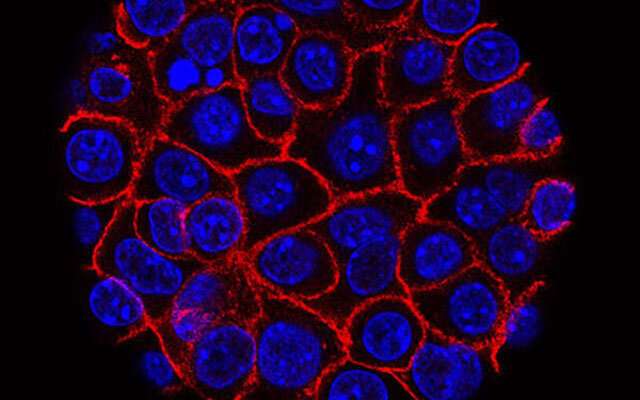

A new approach to ‘prime’ the tumor environment may improve how effective chemotherapy is for pancreatic ductal adenocarcinoma, one of the most aggressive forms of pancreatic cancer.
In preclinical models, a team at the Garvan Institute of Medical Research could enhance the tumors’ response to chemotherapy by reducing the stiffness and density of the connective tissue known as the stroma, and reduce cancer spread by up to 50%.
The research has paved the way to a clinical trial that will assess whether the therapy approach will be effective for pancreatic ductal adenocarcinoma patients.
“By making cancer cells more sensitive to chemotherapy, we hope to improve survival rates for pancreatic cancer patients,” says Professor Paul Timpson, Cancer Research Theme Leader at the Garvan Institute and co-senior author of the findings published in Science Advances. “This work is a powerful example of cutting-edge research in the laboratory leading to partnership with industry and potential clinical translation.”
New approach to one of the most lethal cancers
Pancreatic ductal adenocarcinoma is an aggressive form of pancreatic cancer and one of the most lethal cancers worldwide. Despite advances in combination chemotherapy approaches, the 5-year survival rate is less than one in ten, and below 3% if the cancer has already metastasised.
“We wanted to try and improve on chemotherapy using a unique approach—targeting the environment around the tumor to make the cancer more sensitive to treatment,” says Dr. Kendelle Murphy, first author of the paper.
The researchers investigated FAK—a molecule produced by pancreatic cancer that increases the stiffness of the stroma and helps cancer cells to grow, mobilize and metastasise. Using state-of-the-art intravital imaging techniques to reveal how live pancreatic cancers in mouse models respond to treatment, the researchers investigated whether blocking FAK using an experimental therapy could ‘prime’ cancer cells to be more readily destroyed by chemotherapy.
“When we administered a treatment that targeted FAK prior to chemotherapy in our experimental models, that’s when we saw the most benefits,” says Dr. Murphy.
“By pre-treating the tumors with the FAK inhibitors we were changing the stiffness as well as the amount and the deposition of stromal tissue surrounding the cancer cells. On this softer surface, the cancer cells became stalled, rendering them more sensitive to chemotherapy. Effectively, we were increasing the window of vulnerability of these cancer cells to chemotherapy, reducing both pancreatic cancer growth and spread in our models.”
A way to determine who will benefit most
The researchers also discovered that the levels of another protein in pancreatic cancer cells, called merlin, may help identify which individuals would benefit most from FAK targeting.
“Merlin is a protein that is produced at different levels in pancreatic cancer patients. We found that low levels of merlin in our experimental pancreatic cancer models resulted in our ‘priming’ combination approach targeting FAK being more effective,” says Dr. David Herrmann, co-senior author of the study.
“We hope that by determining which tumors produce less merlin, we will be able to identify which patients are likely to benefit most from our new combination approach.”
The findings will be investigated as part of a new clinical trial in collaboration with Melbourne-based Amplia Therapeutics Limited, which is set to begin Phase II clinical trials of its FAK inhibitor AMP945 next year to determine if the approach will be effective in patients.
“It is exciting for Amplia to be able to work with Garvan’s extensive experience in FAK biology, cancer biology and clinical expertise. The results of the pre-clinical studies have provided important insights and validated our decision to progress our FAK inhibitor, AMP945, to Phase II clinical trial in pancreatic cancer patients,” says Amplia CEO and Managing Director, Dr. John Lambert.
Source: Read Full Article